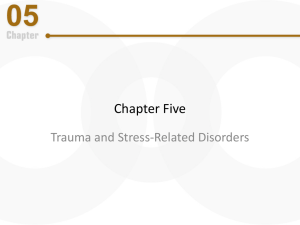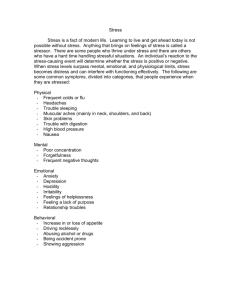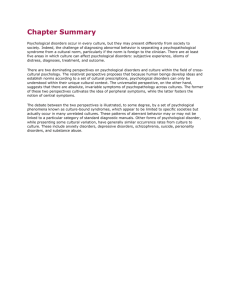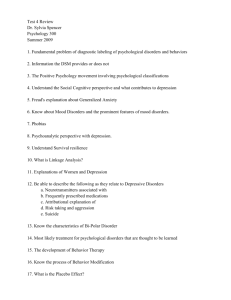Basic Statistics for the Behavioral Sciences
advertisement
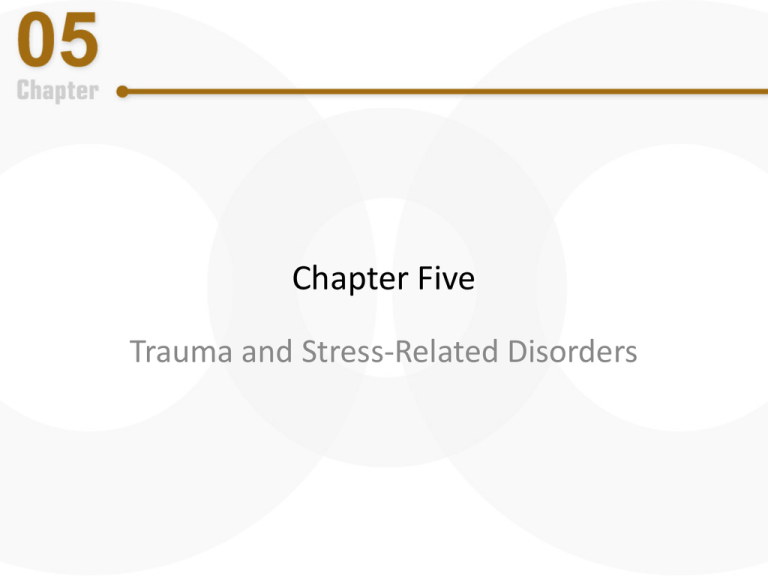
Chapter Five Trauma and Stress-Related Disorders Trauma and Stress-Related Disorders • Stressor: – External event or situation that places a physical or psychological demand on a person – Range from chronic irritation to acute an traumatic events • Stress: – Internal psychological or physiological response to a stressor Acute and Post-Traumatic Stress Disorders • Acute stress disorder (ASD): – Flashbacks, hypervigilance, and avoidance symptoms that occur within one month after exposure to a traumatic stressor • Post-traumatic stress disorder (PTSD): – Flashbacks, hypervigilance, avoidance, and other symptoms that last for more than one month and that occur as a result of exposure to extreme trauma Acute and Post-Traumatic Stress Disorders (cont’d.) • Both begin with a normal response to extremely upsetting circumstances • Fear response remains even though original basis for fear is no longer present • Can also be caused by indirect or “secondhand” exposure Diagnosis of Acute and Post-Traumatic Stress Disorders • Both involve: – Direct or indirect exposure to stressor – Intrusive symptoms and intense physiological reactivity associated with traumatic event – Persistent avoidance of stimuli related to trauma – Alterations in cognitions and mood associated with event and inability to experience positive emotions – Heightened autonomic arousal or reactivity • Hypervigilance Diagnosis of Acute and Post-Traumatic Stress Disorders (cont’d.) Rape & PTSD Listen to a young woman described her symptoms of post-traumatic stress disorder after being raped. Diagnosis of Acute and Post-Traumatic Stress Disorders (cont’d.) • Differ in duration: – ASD lasts three days to one month – PTSD lasts longer than a month • An individual is likely to receive initial diagnosis of ASD and then PTSD if symptoms persist longer than a month Etiology of Acute and Post-Traumatic Stress Disorders Figure 5-1 Multipath Model for PTSD The dimensions interact with one another and combine in different ways to result in PTSD. Etiology of Acute and Post-Traumatic Stress Disorders (cont’d.) • Factors associated with increased risk: – Severe trauma and grave physical injuries • Major burn injuries – Rape and sexual assault – Individual characteristics: • • • • Cognitive style Childhood history Genetic vulnerability Social support Etiology of Acute and Post-Traumatic Stress Disorders (cont’d.) Table 5-12 Lifetime prevalence of Exposure to Stressors by Gender and PTSD Risk Some traumas are more likely to result in PTSD that others. Significant gender differences were found in reactions to “being threatened with a weapon” and “physical attack.” What accounts for the differences in risk for developing PTSD among the specific traumas and for the two genders? Source: Callenger et al. (2000) Biological Dimension • ASD and PTSD are not biologically normative stress responses – Nervous system has become highly reactive to fear and stress • In PTSD: – Individual demonstrates increased biological reactivity – Exaggerated sensitivity to stimuli – Diminished ability to inhibit fear response Biological Dimension (cont’d.) • • • • • Role of the amygdala Hypothalamic-pituitary-adrenal (HPA) axis Epinephrine and cortisol Effect on medial prefrontal cortex Individuals with specific biological vulnerabilities have an increased risk of PTSD • Epigenetic factors may be involved The Stress reaction: Hypothalamus-Pituitary- Adrenal Axis The HPA axis includes three specific parts of your body: • 1) the hypothalamus (part of your forebrain); • 2) the pituitary gland (just below the hypothalamus); • 3) the adrenal glands (at the top of the kidneys). • These three parts work together to regulate functions such as stress response, mood, digestion, immune system, libido, metabolism • These three parts work together to regulate functions such as stress response, mood, digestion, immune system, libido, metabolism and energy levels. Before understanding how to fix your HPA axis, it’s important to understand how the axis works in the first place, so let’s dive into the specific chemicals utilized by your HPA axis. • 1. Corticotropin-Releasing Hormone (CRH) • Also referred to as corticotropin-releasing factor (CRF), this hormone is produced and secreted by the hypothalamus in response to stress, and it then stimulates your pituitary gland to secrete adrenocorticotropic hormone. The more stressed your body is (from diet, lifestyle, work, or anything else) the more CRH your hypothalamus will churn out. • 2. Adrenocorticotropic Hormone (ACTH) • ACTH is released by the pituitary gland, and travels to your kidneys to stimulate the adrenal glands to increase production of glucocorticoids. • 3. Glucocorticoids • The glucocorticoids produced in the adrenal glands are steroids that are necessary regulating metabolic rate, inflammation and immune response. You’ve already learned about the most notorious glucocorticoids: cortisol. • 4. Cortisol • Cortisol is best known for activating our physical response to stress, including injury, lack of sleep, excessive exercise, anxiety, and depression. It prepares your body to withstand these stressful triggers by stimulating norepinephrine (also known as noradrenaline) to active your fight-and-flight reaction. • • It’s important to understand is that your HPA axis operates on feedback loops. • So let’s take a look at how a feedback loop would take place in the HPA – in this case with regards to cortisol. At the same time that cortisol activates your fight and flight stress response, it also sends a signal back to your hypothalamus to inhibit CRH production and your pituitary gland to inhibit ACTH. In this feedback loop, cortisol is also able to reduce norepinephrine activity, gradually calming you down and creating a well-functioning checks-and-balances system Psychological Dimension • Preexisting conditions such as anxiety and depression found to be risk factors for PTSD • Dysfunctional cognitions regarding oneself or environment • Positive cognitive styles increase resilience and reduce risk of PTSD Social Dimension • Less than optimal social support during childhood and adulthood • Pre-existing family conflict or over protectiveness may increase impact of stress • Social isolation • Lack of social support after trauma may be most important factor Sociocultural Dimension • Ethnic differences, possibly due to pre-existing variables • Perceived discrimination • Women are twice as likely as men to suffer stress disorder • Moderate amount of adversity can generate resiliency Treatment of Acute and Post-Traumatic Stress Disorders • Biological: – SSRI antidepressants • Psychological: – Psychotherapy focus on extinguishing fear or to correct dysfunctional cognitions – Exposure to cues associated with trauma – Identify and challenge dysfunctional cognitions – Mindfulness training Psychological Factors Affecting Medical Conditions • Medical evidence suggests attitudes and emotional states have impact on physical wellbeing • Psychophysiological disorder: – Physical disorder that has a strong psychological basis or component • Psychological or behavioral factors adversely influence medical disorder (DSM-5) Characteristics of Psychophysiological Disorders • Actual tissue damage, a disease process, or physiological dysfunction • Medical treatment and psychotherapy usually required • Contribution of physical and psychological factors vary greatly Characteristics of Psychophysiological Disorders (cont’d.) • Coronary heart disease: – The narrowing of cardiac arteries due to atherosclerosis, resulting in restriction or partial blockage of flow of blood and oxygen to heart – Risk factors: • High cholesterol, hypertension, obesity, cigarette smoking, and lack of physical activity – Psychosocial risk factors: • Depression, perceived stress, and difficult life events Characteristics of Psychophysiological Disorders (cont’d.) • Hypertension: – Stressors impact blood pressure – Chronic condition characterized by blood pressure of 140 over 90 or higher – More than 74 million U.S. Americans have high blood pressure requiring treatment – Found in 34% of men and 22% of women Characteristics of Psychophysiological Disorders (cont’d.) • Migraine, tension, and cluster headaches: – Migraine headaches: • Moderate to severe pain resulting from abnormal brain activity affecting the cranial blood vessels and nerves – Tension headaches: • Produced by prolonged contraction of scalp and neck muscles, resulting in constriction of the blood vessels and steady pain Characteristics of Psychophysiological Disorders (cont’d.) • Migraine, tension, and cluster headaches: – Cluster headaches: • Excruciating stabbing or burning sensations located in the eye or cheek Characteristics of Psychophysiological Disorders (cont’d.) • Asthma: – Chronic inflammatory disease of the airways in the lungs – Reduction in the amount of air that can be inhaled – In U.S., prevalence has increased dramatically Stress and the Immune System • Stress itself does not appear to cause infections, but it may decrease immune system’s efficiency, thereby increasing susceptibility to disease • Part of stress response involves release of several hormones that can impair immune functioning Stress and the Immune System (cont’d.) • Exposure to chronic stress appears to increase vulnerability to infection and accelerates progression of disease by decreasing immunity • Connection between stress and naturally occurring cancer has yet to be demonstrated Etiology of Psychophysiological Disorders Figure 5-9 Multipath Mode for Psychophysiological Disorders The dimensions interact with one another and combine in different ways to result in a specific psychophysiological disorder. Biological Dimension • Stressors can dysregulate HPA axis and sympathetic nervous system through release of hormones (e.g., epinephrine, norepinephrine, and cortisol) • Changes in brain structure and in the stressresponsive neurobiological systems due to early environmental influences • Genetic influences Psychological Dimension • Psychological and personality characteristics can mediate effects of exposure to stressors – Positive affect: • Optimism, happiness, joy, and contentment – Hardiness: • Commitment, control, and challenge – Personal control and perception of control – Positive emotions: optimism – Negative emotional states can elevate risk: • Depression, hostility, anxiety, and cynicism Social Dimension • Childhood adversities linked to adult onset headaches and hypertension • Divorce, separation, and abrasive marital relations all linked to negative health changes • Having social support linked to positive health • High quality relationships linked to reduced physiological reactivity to stress Sociocultural Dimension • • • • Discrimination Cultural expectations Conflicts with societal standards Women more likely to be impacted by stress due to care-giving role • Exposure to racism Treatment of Psychophysiological Disorders • Relaxation training: – Learn to relax muscles of the body in almost any circumstance • Biofeedback training: – Learn voluntary control of specific physiological function of interest (e.g., heart rate, blood pressure) Treatment of Psychophysiological Disorders (cont’d.) ABC Video: Biofeedback Training Discover how an at-home biofeedback machine can help manage stress, and learn the theories of how biofeedback works. Treatment of Psychophysiological Disorders (cont’d.) • Cognitive-behavioral intervention: – Anger management and assertiveness training – Social-cognitive processing programs to help to adjust and find validation and meaning – Improve coping skills and manage stress
